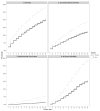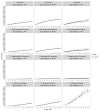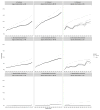Hepatitis C virus-related complications are increasing in women veterans: A national cohort study
- PMID: 28815822
- PMCID: PMC5638671
- DOI: 10.1111/jvh.12728
Hepatitis C virus-related complications are increasing in women veterans: A national cohort study
Abstract
There are gender-specific variations in the epidemiology and clinical course of hepatitis C virus (HCV) infection. However, few long-term longitudinal studies have examined trends in the incidence and prevalence of serious liver complications among women compared with men with HCV infection. We used the Veterans Administration Corporate Data Warehouse to identify all veterans with positive HCV viraemia from January 2000 to December 2013. We calculated gender-specific annual incidence and prevalence rates of cirrhosis, decompensated cirrhosis and hepatocellular cancer (HCC) adjusting for age, diabetes, HIV and alcohol use. We also calculated the average annual per cent change (AAPC) for each outcome by gender using piecewise linear regression in the Joinpoint software. We identified 264 409 HCV-infected veterans during 2000-2013, of whom 7162 (2.7%) were women. There were statistically significant increases over time in the incidence rates of cirrhosis, decompensated cirrhosis and HCC for both men and women. The annual-adjusted incidence rates of cirrhosis, decompensated cirrhosis and HCC were higher in men than women for all study years. However, these complications increased at a similar rate in both groups. Specifically, the AAPC for cirrhosis was 13.1 and 15.2, while it was 15.6 and 16.9 for decompensated cirrhosis and 21.0 and 25.3 for HCC in men and women, respectively (all test of parallelism not significant). The results were similar in the prevalence analyses, although AAPCs were slightly smaller for each outcome. In conclusion, we found an ongoing upward trend in the incidence and prevalence of HCV complications in this cohort of HCV-infected women. This increase in cirrhosis complications in women with active HCV infection is similar to those in men. With cure from HCV now becoming a reality, most of the projected burden of HCV is potentially preventable. However, benefits of HCV treatment will need to extend to all patients in order to stem the rising tide of HCV complications.
Keywords: hepatitis C virus; cirrhosis; hepatocellular carcinoma; veterans.
Published 2017. This article is a U.S. Government work and is in the public domain in the USA.
Conflict of interest statement
Figures




References
-
- Moyer VA. Screening for hepatitis C virus infection in adults: U.S. Preventive Services Task Force recommendation statement. Ann Intern Med. 2013;159:349–357. - PubMed
-
- Uhanova J, Tate RB, Tataryn DJ, Minuk GY. A population-based study of the epidemiology of hepatitis C in a North American population. J Hepatol. 2012;57:736–742. - PubMed
-
- Deuffic S, Buffat L, Poynard T, Valleron AJ. Modeling the hepatitis C virus epidemic in France. Hepatology. 1999;29:1596–1601. - PubMed
-
- Poynard T, Bedossa P, Opolon P. Natural history of liver fibrosis progression in patients with chronic hepatitis C. The OBSVIRC, METAVIR, CLINIVIR, and DOSVIRC groups. Lancet. 1997;349:825–832. - PubMed
Publication types
MeSH terms
Grants and funding
LinkOut - more resources
Full Text Sources
Other Literature Sources
Medical

